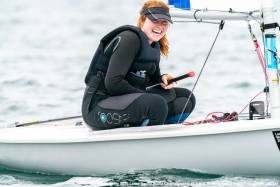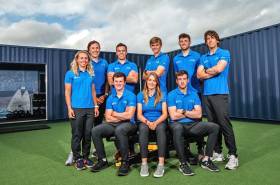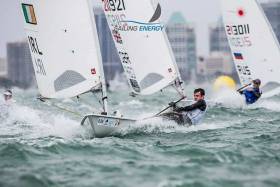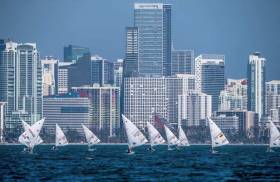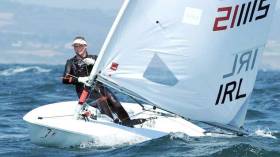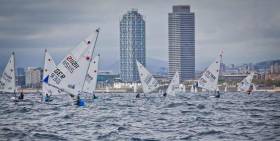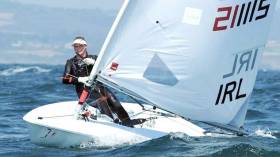Displaying items by tag: Aoife Hopkins
Lough Derg Yacht Club's Aisling Keller Continues to Lead Irish Laser Radial Hopes in Japan
Lough Derg Yacht Club's Aisling Keller continues to lead Irish hopes of Olympic qualification at the Laser Radial World Championships today.
Both Irish women competing at the World Championships in Sakaiminato, Japan achieved top 20 results as the pair aim to secure the single place for Ireland at the Tokyo 2020 Olympic Games.
Aisling Keller (Nenagh, Co. Tipperary) had a 14th place while Aoife Hopkins (Howth, Co. Dublin) was 17th in the single race day for their 55-boat Blue flight.
The moderate breeze that the two qualification flights started in proved quite unstable and soon eased to near calm conditions. Plans for a second race were dropped.
As Afloat reported previously, a second day of slack winds on Miho Bay has put the qualification round behind schedule and while three races may be attempted on Sunday, the finals series must begin on Monday regardless.
Two races on Sunday would see the series discard come into force and allow Hopkins to drop her 34th place from the opening day to maximise her potential to achieve Gold fleet for the finals.
“We have good momentum now so I’m pretty happy that Aisling and Aoife have settled in,” said Rory Fitzpatrick, Irish Sailing’s Head Coach.
Ten nation places for the women’s single-handed dinghy in Tokyo will be decided at this world championship in addition to the 20 already allocated from 2018 events. Either or both Irish sailors must first qualify for Gold fleet on Sunday and score well by Wednesday’s final race to achieve Irish qualification.
Two of Ireland’s most promising sailors in Aoife Hopkins and Katie Tingle have been the subject of separate profiles in recent days.
Katie Tingle has been making her big comeback after a broken arm put her and Annalise Murphy’s 49erFX training regimen on pause last autumn.
But it’s also been part of a longer return for the Cork sailor, who swapped competitive racing for coaching after success in the Optimist class as a junior last decade.
A reconnection with former junior peer Annalise on the Wednesday night scene in Dublin led to a fateful phone call a year ago, from the Olympic silver medallist to the primary school teacher: did Katie want to join her 49erFX Olympic campaign?
“I don’t think she’d have asked me if she didn’t think I could do it and I wouldn’t have said yes if I didn’t think deep down that I could do it either,” Katie tells The42.ie.
The 29-year-old was already deep into training and conditioning when Annalise returned from her stint in the Volvo Ocean Race, and the two started getting to grips with their new boat on Dublin Bay — the Olympian learning from Katie who had previous experience in two-handed dinghies.
However, a freak incident just weeks into training left Katie with a broken arm — and out of the water for four crucial months.
As needs must, Annalise shortly after resumed training over the winter in the warmer climes of Portugal, with Adam Hyland in Katie’s stead — while Katie hit the gym as soon as doctors allowed get back on the road to sailing fitness.
Earlier this year Annalise and Katie, how fully healed up, reunited and got back in their groove with the challenging 49erFX as their first big test — and first Tokyo 2020 qualifier — looms in Genoa just two weeks from now.
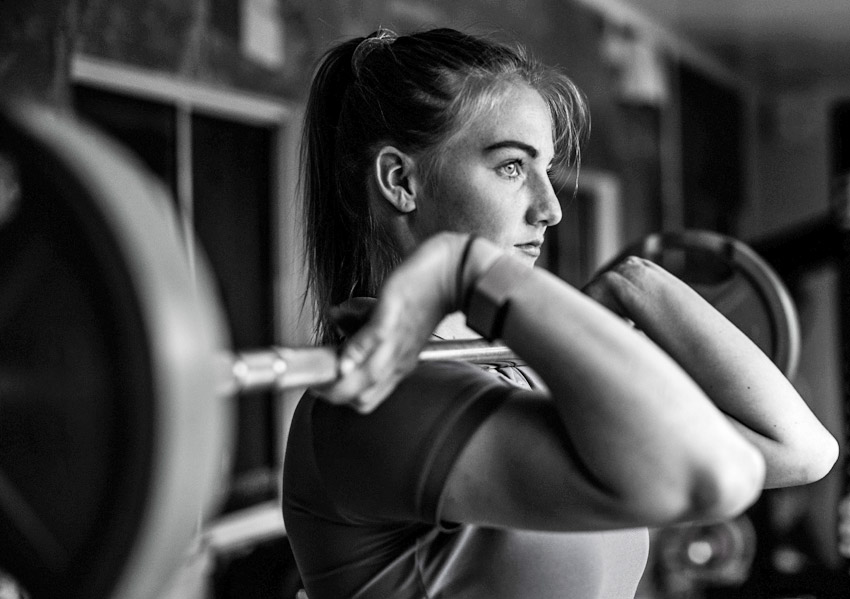 Aoife Hopkins weight training | Photo: Irish Sailing
Aoife Hopkins weight training | Photo: Irish Sailing
Another young sailor who faces a big test in Genoa is Howth Yacht Club’s Aoife Hopkins.
The Laser Radial ace not only steps into the significant gap left by Annalise Murphy, whose Rio 2016 silver medal was in the class — she’s also in competition with teammate Aisling Keller for the single slot available to Ireland.
Aoife tells The Irish Times how she juggles the training regimen of her Tokyo 2020 campaign with the demands of her maths degree at Trinity College, not to mention the various expenses associated with performance sailing at the highest level.
In a boost to their aspirations, Aoife and her fellow performance sailors now benefit from Irish Sailing's new Performance Headquarters in Dun Laoghaire, as previously reported on Afloat.ie.
Tonsillitis Rules Hopkins Out of Princess Sofia Regatta in Palma
A recurring case of tonsillitis rules out Howth Yacht Club Laser ace Aoife Hopkins from this week's Princess Sofia regatta in Palma.
"I'm really gutted to have to announce that I will not be competing", Hopkins told Afloat.
Over the last three weeks Hopkins says she hasn't been able to recover in time to either train or race.
"This has been incredibly frustrating as Palma was where I was looking forward to putting winter training to the test and applying the lessons learned in Miami".
Hopkins expects to contest the Senior Europeans in May.
Howth Yacht Club’s Aoife Hopkins Gets Mercedes-Benz Support
#Tokyo2020 - Mercedes-Benz has extended its involvement in sailing with its support of Howth Yacht Club’s Aoife Hopkins as she prepares her challenge to qualify for Ireland’s team at the forthcoming 2020 Olympic Games in Tokyo.
The arrangement sees Mercedes-Benz retain its status as the only vehicle manufacturer supporting Ireland’s bid for further Olympic glory in the Laser Radial class, in which Annalise Murphy won the silver medal at Rio 2016.
From Howth, 19-year-old Aoife Hopkins is currently Women’s Laser Radial Irish champion and U21 European champion, following her gold medal win at the 2017 Europeans in France — which earned her Afloat.ie’s Sailor of the Month honour for July 2017.
Daughter of Niamh and Troy Hopkins, Aoife hails from a family of sailors and herself started sailing when she was only nine years old.
Her father and brother Daniel currently sail Lasers, while her other brother Conor formerly took part in the sport, all at Howth.
A former student of Santa Sabina school in Sutton, where she achieved more than 600 points in the Leaving Cert, Aoife is now a first year maths student under a sports scholarship at Trinity College Dublin.
“I am delighted to have the support of Mercedes-Benz whose involvement in sailing ensures that my preparations for Tokyo are off to a flying start,” she said at the announcement this week.
Aoife has taken delivery of a 181-registered Vito Mixto, which she will use to transport her team, herself and her equipment to events both here in Ireland and overseas.
Fitted with features fit for a sailing star, specifications include a leatherette interior, leather multi-function steering wheel, interior chrome package, air conditioning, audio 15 sound system, a reverse camera and more.
It will have an eye-catching presence at sailing events throughout Ireland and beyond thanks to its subtle yet eye-catching silver and grey livery.
Wishing her every success in her preparations for Tokyo, Fergus Conheady, sales manager for Mercedes-Benz commercial vehicles, told Aoife: “We are proud to support another of Ireland’s amazing young sailors and wish them every success as they challenge to be the sole competitor in the Laser Radial class to qualify to represent Ireland.”
Laser Sailor Finn Lynch Makes Top Half in Miami
Florida's Biscayne Bay proved a tough but valuable testing ground for both of Ireland's Laser sailors on the road to Tokyo 2020 at the Miami Sailing World Cup this week.
Once the breeze was on in day two, the National Yacht Club's Finn Lynch scored a 15,18, some promising results for the 21–year–old, who won gold at the 2014 U19 World Championships. As it turned out, the teen results were Lynch's best individual results of the nine race series, ending up 32nd in his 70–boat fleet overall.
Aoife Hopkins from Howth Yacht Club ended up 43rd from 68th in the Radial fleet that saw her posting similar results in both heavy and light winds. The U21 Euro Champion got off to a bad start with gear failure on day one. A capsize in heavy winds on the run into the line cost the Trinity Student dearly in the second race on day two. Her best result of the eight races sailed was a well–earned 23rd in race six. This is the start of her 2018 campaign towards the Olympic qulaifiers in August, so the experience Stateside this week will have been a worthwhile one, early in the year.
Overall results are here.
With five sailors in striking distance of the gold medal and seven mathematically alive for a podium position, the Medal Race for the Women's RS:X at the 2018 World Cup Series Miami, USA, was projected to be the most exciting of the five Medal Races scheduled for the penultimate day of the regatta.
Watch the early Medal Races here
And it delivered with abundant speed and excitement in champagne sailing conditions on Biscayne Bay.
When the spray cleared, Hélène Noesmoen (FRA) was zipping across the finish line in first in excess of 20 knots and, in the process, moving from fourth to first in the overall standings. Rounding out the medals were Flavia Tartaglini (ITA) and Blanca Manchon (ESP).
"Today was windy, and I think that is my strong point,” said Noesmoen. "I tried to keep consistent during the week and really push myself in the Medal Race, and it paid off. I had a bad second day, I think that was due to the wind conditions, which dropped me to the middle of the [results] table. But I had an amazing third day, which kept me in the top 10 and allowed me to compete at the Medal Race.”
The turning point in the double-points Medal Race came on the first downwind leg when Stefania Elfutina (RUS), the defending Olympic bronze medalist and regatta leader going into the day, caught the edge of her board after leaping off a wave and crashed into the water. It the time it took her to recover her sail and get going again, five sailors—and her medal chances—passed her by. One of those zipping past was Noesmoen, who rounded the second of five marks in sixth place. While the breeze velocity was quite steady, there were gains to be made by playing the shifts correctly. On the third leg, Noesmoen found an elevator to the podium, moving to second and then to first for the final two legs of the race.
"This race was going well for me until I crashed on the first downwind close to the gate,” said Elfutina. "I'm not sure what happened. I'm trying not to feel disappointed with myself. I enjoyed this regatta and my races. I learned a lot of things on the water. I can't really say what I learned [about preventing what happened in the final race], it's just an instinct that your body adjusts to on the water, and it becomes a reflex.”
For the first time, World Sailing employed a reaching start and finish for the RS:X divisions. For sailors that are used to parking close to the starting line and accelerating at the last second—typical of a start in the RS:X class—this America's Cup-inspired course format required a retooled starting strategy. But the course, which features four reaching and downwind legs and two upwind legs, was generally met with positive reviews.
As was the case with the Women's RS:X, no team in the Men's 49er fleet had secured a podium position of any color going into the Medal Race. But unlike in the RS:X division, the form guide held true with world champions Dylan Fletcher-Scott and Stuart Bithell (GBR) staying right in lockstep with Diego Botín le Chever and Iago López Marra (ESP) throughout the race and ensuring that the British team would emerge from the race with the gold medal. Holding on for third, though they did put themselves in a bit of trouble by rounding the first mark in ninth, were Federico Alonso Tellechea and Arturo Alonso Tellechea (ESP).
"It was brilliant fun out there,” said Bithell, a silver medalist in the 470 class. "We had good breeze and plenty of sunshine. The Medal Race is pretty quick. It was really exciting, and we were just full of adrenaline. It's just incredible sailing [the 49er]. It was hectic but Dylan did a really good job.
"Our strategy initially was to start at the boat end, windward of the Spanish. But we got a little late at the start so we had to go to Plan B, which was to be a bit quicker so we just had to use our speed.”
Though they were, effectively, as far ahead of third place as they were behind first, Botín le Chever and López Marra attacked the racecourse with the aim of getting a gold.
"We needed to put the boat between the British and us to win,” said Botín le Chever. "So we went full-on in the start. The wind was really strong so we had to keep the boat upright. We found ourselves in second place. We needed to overtake the Austrians and we did it. We thought that we'd won the regatta, but then we found out that we were second. Congrats to the British.”
Unfortunately for the Spanish duo, the Austrian team that crossed the line second in the race had crossed the starting line early and was disqualified from the race. But the silver medal is a strong result for this team, which was ninth at the Rio 2016 Olympic Games.
"It's a really good position for us,” said Botín le Chever. "We have some of the greatest 49er sailors here. This event is motivation for us to keep on working hard. We have a lot of regattas ahead, we still have a long way ahead.”
Victoria Jurczok and Anika Lorenz started the Medal Race in the 49erFX class with a comfortable cushion. But in the spicy wind and chopped wave conditions—and multiple capsizes—no lead was safe. So the German duo kept the pedal to the metal and finished second in the race behind Stephanie Roble and Maggie Shea (USA).
"It was a hard wrestle for us today,” said Lorenz. "Our main focus on the boat was to make sure that all the manoeuvers were safe and that we didn't capsize. We were not really focusing on the other boats.”
The Norwegian team of Ragna and Maia Agerup was one of the boats that capsized, but in the end it didn't cost them a place in the overall standings. They took silver with Tanja Frank and Lorena Abicht (AUT) in third.
Even for the sailors at the front of the Nacra 17 class, today's race was a learning experience. The 19-21 knots conditions, with 1-meter chop, were right on the edge of what the boats can handle, especially given the fleet's relative inexperience with the lifting foils, which were added to the class less than a year ago. Upwind, most teams chose to keep one hull in the water and go for height over speed. Downwind, however, it was a wild ride with both hulls riding a meter or more out of the water at times. One sailor was swept overboard when her boat crashed down into the water after foiling downwind at 25 knots. She was quickly recovered and her team finished the race.
Lisa Darmanin and skipper Jason Waterhouse (AUS) started the race with a 19-point lead, which meant they only needed to finish the race to ensure the gold medal. Instead they added one more victory to their scorecard, showing exceptional control in challenging conditions.
"We're from Australia,” said Darmanin, a 2016 Rio silver medalist, "so we love the breeze.”
Defending gold medalists Santiago Lange and Cecilia Carranza Saroli (ARG) were last around the first two marks, but showed remarkable speed on the final downwind leg, going from seventh to third and preserving the silver medal. Thomas Zajac and Barbara Matz (AUT) were sixth in the race and third overall.
With a second in the Medal Race in the Men's RS:X, Kiran Badloe broke up a potential one-two finish for France. But it would've taken a perfect race and quite a bit of help from the rest of the fleet to unseat Louis Giard (FRA) who started the final race with a 13-point advantage. Tom Squires (GBR) won the race. Pierre Le Coq (FRA) was sixth in the race, which was enough to keep him on the podium.
"Today the conditions were incredible, I really enjoyed the racing,” said Giard. "A lot of the guys in the RS:X class are really good. So we had really close competition and all the time you have to constantly be looking out because if you open a small window someone will slip in.
"I can't really put my finger on [the key to my success], but I just try my best and I try to enjoy this competition.”
The Finn, Laser and Laser Radial and Men's and Women's 470 sailed today and will have their Medal Races tomorrow.
In the Finn class, Giles Scott (GBR) holds first position with a 19-point lead over the Turkish sailor, Alican Kaynar. Caleb Paine (USA) sits third in the fleet.
Tom Burton (AUS) has an unassailable lead in the Laser class with a 30-point cushion over Nick Thompson (GBR). After the tough battle for second place with Thompson, throughout the week, Philipp Buhl (GER) lands in third place on the leaderboard.
Alison Young (GBR) climbed up the fleet and managed to gain first place in the Laser Radial.
Emma Plasschaert (BEL) had led for the majority of the week however she drops to second. The Rio 2016 bronze medalist, Anne-Marie Rindom (DEN) is third.
In the Men's 470, Luke Patience and Chris Grube (GBR) lead the fleet with 17-points ahead of Kevin Peponnet and Jeremie Mion (FRA). The Swedish, Anton Dahlberg and Fredrik Bergström hold third spot.
Tina Mrak and Veronika Macarol (SLO) move up from fourth to first in the Women's 470. Afrodite Zegers and Anneloes van Veen (NED) take second and Agnieszka Skrzypulec
Irmina Mrózek Gliszczynska (POL) third.
The dinghies will sail their Medal Races tomorrow with the racing scheduled to commence at 12:00. You can watch the remaining Medal Races live here: www.youtube.com/watch?v=pZcq-EHxZ3M
Hopkins Bounces Back After Gear Failure at Miami Sailing World Cup
Equipment failure meant an inauspicious start for Trinity College student Aoife Hopkins at the Miami Sailing World Cup yesterday. The Howth Yacht Club sailor did, however, manage a 26th in the third Laser Radial race to be placed 57th from 68 after two days of light air racing so far in Florida. Conditions are expected to improve today.
In the mens Laser division, Finn Lynch from the National Yacht Club is 38th from 70 on Biscayne Bay. Lynch has arrived in Miami on the back of training camps in Cadiz and a podium finish in Gran Canaria Olympic Week.
Results are available here
Contrary to the other seven boats that are currently used for Olympic sailing, the RS:X Windsurfer is at its most physically demanding in lighter air.
It isn't so different from a 5,000-meter foot race. In fact, given the full body contraction required to fan the large sail, it may even be more taxing. And while the relentless pumping is essential to a good result, tactics do still play an integral role, requiring athletes to think clearly while at their physical redline.
"It was tough always, but it was successful,” said Stefania Elfutina (RUS), the bronze medalist in the class from the Rio 2016 Olympic Games. "The light winds meant we had to pump more and that made it tough, because after the second race, I was so tired. I lost all my strength on the water. I am pretty happy with today's result though, I scored a 4, 2 and 2.”
Normally, a scoreline such as that would be an express ticket to the head of the leaderboard. But Israel's Noga Geller (ISR) showcased her superior fitness today, winning all three races, to go along with a second in yesterday's lone race. After two days, she has a five-point lead over Elfutina, who is nine points clear of Fujiko Onishi (JPN) in third.
"I had a good day,” said Geller. "All my races were smooth, and I kept good speed and tactics in all. The offshore wind was pretty stable, so I had to find the pressure and take the right shift at the right time. I kept pumping after the start and during downwind. It was really close between [Stefania and I], especially the last race. I started second and I caught up on the gate. In the end, I went to the better side, which paid off.”
Elfutina likened the finish of the third race to a battle of wills, "We were quite close throughout the race, but we were so tired that we didn't even fight much to win. We both sailed on different sides and met again towards the finish. I think she had more power than me and managed to use that to win.”
Israel has long been a powerhouse in Olympic windsurfing. And this cycle is no exception. For Geller, simply making the Olympic team may be just as challenging as winning a medal. Maya Morris (ISR) is sixth in the overall standings with 22 points while Hadar Heller (ISR) is seventh just a point behind. Of the seven Olympic medals Israel has won since 1996, three have come in Windsurfing. Whether it's Geller, or one of her teammates, who represent Israel in 2020 in Tokyo, there is a good chance to build upon that legacy.
That, however, is a long way down the road. The immediate future involves six more full-fleet races and then the Medal Race on Saturday. Elfutina, for one, is hoping for a little more wind.
"The next few days should be windy and I know I'll have to pump less,” said Elfutina, "hopefully I can focus more on strategy than strength.”
In the Men's RS:X fleet, the Swiss, Mateo Sanz Lanz finished first on the leaderboard followed by close rival, Pawel Tarnowski (POL) and Ivan Pastor Lafuente (ESP) in third.
After not even leaving the dock yesterday, the 26 competitors in the Men's Heavyweight Dinghy division, a.k.a. the Finn class, were happy to get in three races today. This regatta marks the return to World Cup Series competition for two medalists from the 2016 Rio Olympic Games, gold medalist Giles Scott (GBR) and bronze medalist Caleb Paine (USA).
However it was Ioannis Mitakis (GRE) who ruled the day, climbing the ladder with an eighth in the first race, a third in the second and finally a first to close things out.
"It was a hard day,” said Mitakis, who finished 11th in the Rio 2016 Games, missing the Medal Race by a single point. "We had eight knots and three pumping conditions which made it frustrating for us. We were close into the [Rickenbacker Causeway] on the Echo course and that's where it gets shifty. Overall it was tough, but I think I did okay.”
Paine, who sits sixth, but just four points off the lead, agreed with Mitakis' assessment of the wind on the race course.
"It was a very tricky day of sailing,” he said. "It was oscillating back and forth and had different pressure differences. The downwinds were quite tough as well, just trying to stay in the pressure, which was fairly difficult to see. I had some pretty mediocre starts, but was able to adjust through the shifts to get back into the race and had an okay day.
After winning a bronze in Rio, Paine too some time away from the campaign trail. He started training again last fall, and this event is his first major competition on the road to Tokyo. As with the Israeli Windsurfers, Paine knows the value of a strong national training group.
"It's great [to be campaigning again]. I have Luke Muller here and we have a great program, and not being by myself is quite a great thing. We're making great progress when we sail together and I'm just looking forward to sailing. It's an awesome sport, I'm honored and blessed to do it, and look forward to doing it a little bit more.”
A little further downwind from the causeway, the 49erFX fleet was relishing a steadier breeze and ideal water conditions.
"It's not too wavy and the water is quite flat,” said Victoria Jurczok (GER), "it's something different and really fun to sail here.”
Jurczok and teammate Anika Lorenz were the class of the fleet today, picking up a fourth and three firsts and moving into the overall lead by six points.
"We found out the pattern of the shifts for the day,” said Jurzcok, "so we knew what to do and where to go.”
With six races down, the 49erFX fleet is halfway to Saturday's Medal Race. But as well as they've sailed to this point, Jurzcok and Lorenz are not taking anything for granted, especially with the forecast calling for significantly more breeze over the next few days.
"The next few days are going to be windier,” Jurczok added, "so it's going to different game for us.”
In the 49er, Croatians brothers, Sime and Mihovil Fantela continue to hold their lead on day two whilst Dylan Fletcher-Scott and Stuart Bithell (GBR) are in second but equal on points with Benjamin Bildstein and David Hussl (AUT).
It is all to play for in the Laser Radial fleet as the top three sailors are locked on equal points. Viktorija Andrulyte (LTU), champion of the 2017 Laser Europa Cup held in Lithuania, is first followed by Valentina Balbi (ITA) and Vasileia Karachaliou (GRE) in second and third.
The Laser finished the day with Tom Burton (AUS) in first place on the leaderboard. Nick Thompson (GBR) progressed to second and Thomas Saunders (NZL) is in third.
Australian Rio 2016 Olympic silver medalist Nacra 17 sailors, Jason Waterhouse and Lisa Darmanin, dominated today's races winning all three. They hold a nine-point lead over the Great Britain's, John Gimson and Anna Burnet.
The Japanese maintained their dominance in the Men's and Women's 470.
The opening day leaders, Naoki Ichino and Hasegawa Takashi (JPN), defend their top spot in the men's and in the women's fleet, Ai Kondo Yoshida and Miho Yoshioka (JPN) remain first.
Thursday's racing is scheduled to commence at 10:30, local time, starting with the 49er. Schedule, results and live tracking is available below.
Laser Sailors Lynch & Hopkins in Miami for 2018 World Cup Sailing Series
Two Irish Olympic sailing hopefuls for Tokyo 2020 are among 540 sailors have gathered in Regatta Park, Miami, USA, for the second round of the 2018 World Cup Series, running from 21-28 January 2018.
Howth Yacht Club's Aoife Hopkins and Finn Lynch from the National Yacht Club will race in the radial and full rig Laser classes respectively. Full entry lists are here.
Also of Dun Laoghaire interest is 2016 Irish Rio rep Saskia Tidey in the 49erfx, who is now sailing for Team GB.
The event marks the start of a big year for Olympic class sailors, as they prepare for the Hempel Sailing World Championships in Aarhus, Denmark this summer.
Sailors from over 50 nations will race over six days in all ten Olympic events on Biscayne Bay, just off Coconut Grove in Miami. The fleets will feature 27 Olympic medallists and they, along with all competitors, will come up against a moderate 12 knot breeze, warm temperatures and intermittent showers during the week.
Erika Reineke (USA) is a local Laser Radial sailor and she is very familiar with the waters. As sailors get set up in Regatta Park, Reineke welcomes the international competitors and is looking forward to the event. "It's great to see so many faces from across the world come here,” says Reineke.
Reineke and Women's 470 sailor, Maja Siegenthaler (SUI) both relate to the thought of Dolphins whenever they think of sailing in Miami.
Siegenthaler will be sailing with Linda Fahrni. The pair also competed at the first event of the Series in Gamagori, Japan, and just missed out on a podium spot. However, they are looking to improve on that showing, ready for the Worlds in Aarhus.
In the Men's Laser fleet, Lynch will be up against it, the finest sailors in the class are here in Miami ready to fight for World Cup Series medals. The ones to beat will once again be Rio 2016 gold medallist, Tom Burton, reigning World Champion, Pavlos Kontides (CYP) and 2017 European Champion, Nick Thompson (GBR).
Ahead of the competition Kontides was at ease in Miami and when asked what he thought about the Sunshine State he responded, "Beautiful, warm and vibrant.”
However, Kontides says the competition in Miami isn't easy, "It's always tricky. As you can see from the results, sailors finish with high points and competition is very close. It can be unpredictable.”
The London 2012 Olympic medallist, has his sights firmly set on Aarhus as well.
"I have nice memories from Aarhus from 2008. I was able to win the Youth Worlds back then. Right now, my main focus is on training as much as I can and using this event to prepare for the Worlds,” said Kontides.
Racing is scheduled to commence on Tuesday 23 January with the regatta culminating with the LIVE Medal Race days on Saturday and Sunday, 27 and 28 January.
Gold Fleet Performances for Hopkins & Lynch at Laser Europeans
Aoife Hopkins finished 21st in the Senior European Laser Championships that concluded today in Barcelona. Rio Olympian Finn Lynch, in the men's standard rig division, finished in 33rd.
There was a slight delay in the launching as once again the weather repeated the pattern of the previous days and the sailors had to wait for wind.
Two races were completed In a strong thermal breeze which was a relief to the sailors after the light tricky conditions of the last few days.
Nick Thompson (GBR) took line honours in the men's standard rig followed closely by Francesco Marria (ITA) and Andrew McKenzie (NZL).
In the women's radial fleet Marit Bowmester (NED) the current World Champions and Rio Olympic gold medalist once again dominated. She was followed by Rio silver medalist Anna-Marie Rindom (DEN) with Vasileia Karachaliou (GRE) in third.
The radial men's line up was Marcin Rudawski (POL) followed by Marcelo Cairo Assenza (GRE) and Dimitris Papadimitriou (ESP).
The young Irish team had some exceptional performances in a fleet dominated by seasoned campaigners. The championship consists of the Europeans (European sailors only) and an open event. This event is considered significant by Sport Ireland and sailors are judged on this European result. In Gold Fleet, Aoife Hopkins, who has yet to turn 19, from Howth Yacht Club finished in 21st (23rd open event) with a 6th position in her first race of the day. 22–year–old Rio Olympian Finn Lynch in the men's standard rig division finished in 33rd in the Europeans (37th open event) and also had a good first race scoring a 12th. Ronan Wallace in the men's radial division finished in 43rd (42nd open).
In the silver division (men's standard rig) 18–year–old Ewan McMahon from Howth Yacht Club in his first senior event finished up 4th silver (61st Europeans and 67th open). Aisling Keller from Lough Derg following an unfortunate protest that pushed her from the bottom of gold fleet into the silver fleet sailed at the top of the fleet and finished up 2nd silver (41st Europeans and 47th open). Sally Bell had a better day today scoring an excellent 15th in her first race today and finished 79th in the Europeans (87th open).
This is a critical year in the Irish teams development and they will be training hard all winter in preparation for the Olympic Qualifying event in Aarhus next summer.
Howth Yacht Club's Aoife Hopkins Stays in Top 20, Finn Lynch 35th at Laser Europeans
19–year–old Aoife Hopkins from Howth Yacht Club started the her first day in gold fleet at the Laser European Championships in Barcelona with a mid-fleet result in race one followed by a 31st (discarded) in race two. Hopkins currently lies 20th overall in the 90 boat fleet.
Today’s racing started with a postponement, as the gradient wind that had been there from early morning died away. The sailors settled in and waited for the thermal wind to come in eventually launching at 2:30pm to light shifty conditions.
The Irish sailors that had made Gold fleet discovered that the rumours are true – it is indeed tough at the top!
Rio Olympian Finn Lynch from the National Yacht Club in the Men’s standard rig fleet scored a 54th (discarded) and 33rd and currently lies 31st overall in the 125 boat fleet. Ireland only other gold fleet competitor Ronan Wallace in the men’s radial division is currently scored DNC on the score sheet.
A protest yesterday pushed Aisling Keller from Lough Derg Yacht Club into silver fleet in the women’s radial. Aisling scored a 38th and an 18th leaving her 59th overall. Sally Bell in her first senior European event scored a 45th and 44th . In the men’s standard rig Ewan McMahon also in his first senior event enjoyed some racing at the top of silver fleet to score a 12th and a 4th bringing him up the score sheet nicely to 65th overall.
Results are here.
How Laser Champion Aoife Hopkins Balances Sailing & Study
How do you strike a balance between the sport you love and a life outside it? How do you achieve great results but still have other strings to your bow? A criticism that is often levelled at performance athletes is that they have to sacrifice everything for their sport, which means that they lose the balance in their life between sport and their education or career. Rory Fitzpatrick, Irish Sailing’s Youth & Development Manager has long argued that the most successful sailors are those who strike the correct balance. One such athlete he points to is Irish Sailing Performance Pathway’s Aoife Hopkins, winner of the U21 Laser Radial European Championships this July who achieved a whopping 601 points in her Leaving Cert and is now studying maths at Trinity College Dublin.
We talked to Aoife of Howth Yacht Club about her very busy summer, and how she balances sailing and studying.
Aoife, this summer you managed to score over 600 points in your Leaving Certificate and win the U21 Laser Radial European Championship just a few weeks later. You must be delighted but did this come as a surprise to you?
I was absolutely thrilled as both my exam results and sailing performance reflected two years of hard work put into balancing both. While I was delighted, I wasn’t surprised, as the processes had been in place all along.
Knowing that it would be a busy time how far out were you planning for this?
I actually started planning at the beginning of fifth year when it became clear that I’d be missing a lot of school for sailing. So I guess a full two years!
When you first put the plan together what made it look achievable and worthwhile?
The goal was to get enough time on the water and enough study time to excel at both aspects. The plan, while definitely a challenge, had at least 3 (but usually 4 or 5) days on the water a week while still allowing me to have enough study time (also fitting in an extra subject, applied maths, every day before school). I could see that although my sailing sessions wouldn’t necessarily be long (some were only 1 hour), it was enough that I was keeping touch with the feeling of the boat while continuing to train in a range of conditions. That to me seemed like a success and I was sure that the results would eventually reflect that.
Was there much compromise in your normal school time to balance in sailing over the same time?
Definitely! I missed a huge amount of school in fifth year. I competed in the U21 Europeans (1 week), La Rochelle Olympic Week (1 week), Copa da Brazil (2 weeks), Miami World Cup (2 weeks), Senior Worlds (2 weeks) and Senior Europeans (2 weeks). This was all during term time and doesn’t include all the half days taken to head out to Dun Laoghaire for training. I still got the highest grades in my year in my summer exams that year (613 points). Academics isn’t just about being present in class, it’s about applying yourself to it. I found that if I caught up on homework/study every night, even having missed class, while also writing notes and doing exam questions then I was in the clear. I studied at all the events, my school organised for me to get ebooks for all my subjects. I think with athletes, we’re more focused than the regular student and manage time much more effectively. This means getting more study done in less hours (put down the phones people!). While I missed less school in sixth year (only competing in the Andalusian Olympic Week and Hyeres World Cup during term time), I still had the routines in place to be able to sail 4 days a week, while still getting in gym sessions, cycles (usually as commutes) and study time.
What kind of supports did you have around you to help during the time?
At the start of fifth year I sat down with my year head, vice principal and my coach Rory Fitzpatrick to go through my weekly routine in order to address any conflicts cropping up (eg. I was missing double accounting every single week for training on a Wednesday afternoon, not really a subject you can teach yourself!). This helped as both parties understood how much was expected from me on either side…and both could then make adjustments! I also worked with Eoin Reinisch, Athlete Advisor at Sport Ireland Institute, who had me plan out my week every Sunday night in half hour blocks to ensure I had the correct balance of sailing/fitness/study/relaxation. This made me a lot more efficient and time that I might have wasted otherwise could now be used constructively, obviously I deviated at times but it definitely made me more aware of the opportunities I had to get more work done. Sportsmed were also great, whenever I thought the programme wasn’t doable I let Mark McCabe know and he adjusted it. For example, instead of sitting on a bike for two hours at the weekend I just cycled to/from school, Sportsmed, Dun Laoghaire etc to get that cycling time in without it compromising study. Mark also understood that for this period, sailing had to take priority over shore-based fitness training and he changed my TrainingPeaks to reflect that.
In addition to the support I received from my school and all in Irish Sailing, my parents were a huge help. They took on the role of campaign manager, ultimately giving me the time to train and study as I did. Mum did all the logistics involved in the events (flights, accommodation, boat charter, finding coaching support etc) as well as continuing to fundraise and find private sponsors. All of this is incredibly time consuming (as I've now realised having left school and taking on the job!). My parents' unrelenting support was what got me through two tough years of balancing an Olympic campaign and the Leaving Cert. The value of education has been emphasized in our household for years and has given me the drive to do my best in both school and sport.
What did your normal day and week look like over the period? Was it always the same or were you able to adjust it and if so how?
Sailing 4 times a week, gym twice, cycling for commutes and studying as much as possible. I definitely adjusted at times, depending on the weather forecast (if it was really good I’d sail 6 days in the week, if it was bad it might only be 2 or 3) and also on how close we got to exams. I did the Hyeres World Cup one month before the Leaving Cert started which I actually found great. It got me out of that ‘LC funk’ that starts to creep up in April and May of sixth year. I came home to be on the ‘home run’ and had enough energy to get me through the exams in one piece. I used school breaks as a good opportunity to get 6-8 hours of study done a day plus short sails, those breaks are gold dust…use them wisely!
If you had any advice for any sailors doing the final school year with exams at the start of the next summer what would it be?
First off, keep working! The year does actually fly by (between Halloween, Christmas, mocks, February midterm, St Patrick’s, Easter and then Graduation you’re not actually in school that much!). Use sailing as a tool, remember that the Leaving Cert isn’t a measure of how good a student you are, it’s a measure of how much you apply yourself compared to the rest of the country. The 50,000 other students taking exams don’t have the outlet that you have, to be able to get on the water for 2 hours getting fresh air and a workout, completely switching out of ‘school mode’. Everyone else will ‘halfway study’ for the whole year, doing a few hours then going for a walk, then another few hours, then watching a movie, then another bit, then having dinner. They get so fed up with studying (because they can never switch off like we can) that they never do it right. Use sailing to your advantage, go midweek training so that you can get proper time at a desk without feeling derived, fed up or depressed. Don’t see either academics or sailing as a chore but more as two sides to a coin that can balance each other out perfectly if done right. I can guarantee that if you don’t give one aspect the time it deserves, neither will go as well as they could have.
Go to Irish Sailing’s Facebook page to see a list of Top 10 tips and tricks to balancing sport and studying, and getting the best from both!



























